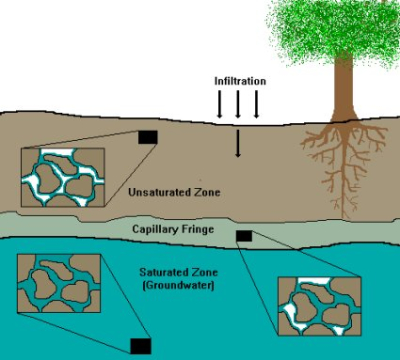
Subirrigation
 The final Central American farming
technique for this week's lunchtime series is subirrigation.
Although I'm used to watering plants from above (or at least using drip
irrigation slightly beneath the soil surface), many traditional Central
American farmers watered their plants from below. When farmers
raise the water table to 1 to 6 feet below the soil surface (depending
on soil texture), water naturally creeps upwards to roots through
capillary action. This damp but not wet region of the soil is
known as the capillary fringe.
The final Central American farming
technique for this week's lunchtime series is subirrigation.
Although I'm used to watering plants from above (or at least using drip
irrigation slightly beneath the soil surface), many traditional Central
American farmers watered their plants from below. When farmers
raise the water table to 1 to 6 feet below the soil surface (depending
on soil texture), water naturally creeps upwards to roots through
capillary action. This damp but not wet region of the soil is
known as the capillary fringe.
By raising or lowering the level of the groundwater, farmers can keep
the damp soil within reach of plants' roots, allowing the plants to
water themselves. The
zanjas (canals) I mentioned in
a previous lunchtime series are primarily built to manage the depth
of the water table in the surrounded garden beds. Beds can be 40
feet wide in clay soil and still be watered by the surrounding zanjas, although beds in sandy soil
are no more than 10 feet wide. In either case, farmers do some
hand-watering (dipped out of the canal) for shallow-rooted plants.
| This post is part of our Central American Permaculture lunchtime
series.
Read all of the entries: |
Want more in-depth information? Browse through our books.
Or explore more posts by date or by subject.
About us: Anna Hess and Mark Hamilton spent over a decade living self-sufficiently in the mountains of Virginia before moving north to start over from scratch in the foothills of Ohio. They've experimented with permaculture, no-till gardening, trailersteading, home-based microbusinesses and much more, writing about their adventures in both blogs and books.
Want to be notified when new comments are posted on this page? Click on the RSS button after you add a comment to subscribe to the comment feed, or simply check the box beside "email replies to me" while writing your comment.
